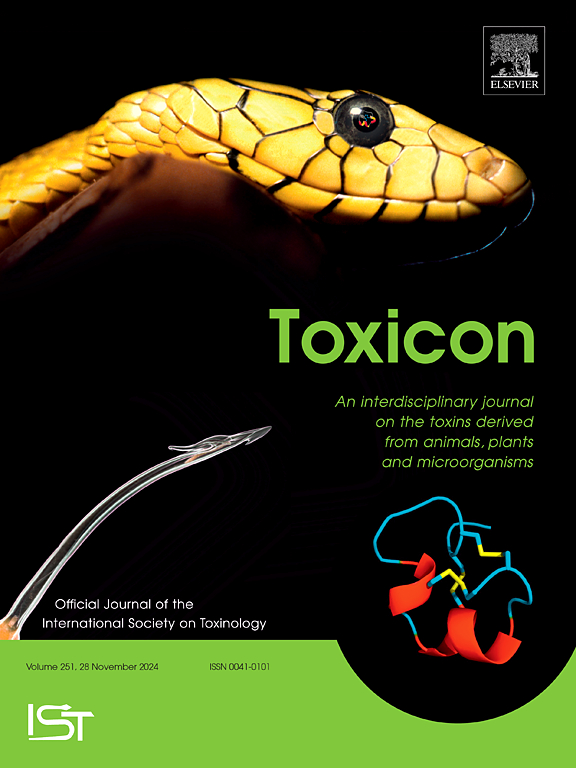Development of chemiluminescent enzyme immunoassay for the detection of aristolochic acid I in patent medicines and cosmetics
IF 2.6
4区 医学
Q2 PHARMACOLOGY & PHARMACY
引用次数: 0
Abstract
Aristolochic acids (AAs) are a family of nitrophenanthrene carboxylic acids. Some AAs-containing herbs are used as raw materials in medicines, health foods, cosmetics, and dietary supplements. However, aristolochic acid I (AAI) as the main active component of AAs, is nephrotoxic, mutagenic, and carcinogenic to humans. Thus, it is essential to develop effective techniques for determining AAI in relevant products. In this study, an anti-AAI monoclonal antibody (mAb) with high sensitivity was generated. Based on the mAb, a chemiluminescence enzyme immunoassay (CLEIA) was developed, exhibiting an IC50 of 20 ng/mL and a linear range from 2.5 ng/mL to 250 ng/mL. The limit of detection (LOD) of the CLEIA was 1.96 ng/mL. The recovery rates of AAI in spiked patent medicines and cosmetics ranged from 79.7 % to 121.7 % with coefficient of variations (CVs) ranging from 1.2 % to 13.6 %. A good correlation coefficient of 0.9591 was observed between CLEIA and high-performance liquid chromatography (HPLC) results, indicating that the developed CLEIA is accurate and reliable for the determination of AAI in patent medicines and cosmetics.

化学发光酶免疫分析法检测成药和化妆品中马兜铃酸I的研究
马兜铃酸(AAs)是一类硝基菲羧酸。一些含砷的草药被用作药品、保健食品、化妆品和膳食补充剂的原料。然而,马兜铃酸I (AAI)作为马兜铃酸的主要活性成分,对人体具有肾毒性、诱变性和致癌性。因此,有必要开发有效的技术来确定相关产品中的AAI。本研究制备了一种高灵敏度的抗aai单克隆抗体(mAb)。基于该单抗,建立了化学发光酶免疫分析法(CLEIA), IC50为20 ng/mL,线性范围为2.5 ~ 250 ng/mL。CLEIA的检出限为1.96 ng/mL。加标成药和化妆品中AAI的回收率为79.7% ~ 121.7%,变异系数(cv)为1.2% ~ 13.6%。CLEIA与高效液相色谱(HPLC)结果的相关系数为0.9591,表明所建立的CLEIA用于中成药和化妆品中AAI的测定准确可靠。
本文章由计算机程序翻译,如有差异,请以英文原文为准。
求助全文
约1分钟内获得全文
求助全文
来源期刊

Toxicon
医学-毒理学
CiteScore
4.80
自引率
10.70%
发文量
358
审稿时长
68 days
期刊介绍:
Toxicon has an open access mirror Toxicon: X, sharing the same aims and scope, editorial team, submission system and rigorous peer review. An introductory offer Toxicon: X - full waiver of the Open Access fee.
Toxicon''s "aims and scope" are to publish:
-articles containing the results of original research on problems related to toxins derived from animals, plants and microorganisms
-papers on novel findings related to the chemical, pharmacological, toxicological, and immunological properties of natural toxins
-molecular biological studies of toxins and other genes from poisonous and venomous organisms that advance understanding of the role or function of toxins
-clinical observations on poisoning and envenoming where a new therapeutic principle has been proposed or a decidedly superior clinical result has been obtained.
-material on the use of toxins as tools in studying biological processes and material on subjects related to venom and antivenom problems.
-articles on the translational application of toxins, for example as drugs and insecticides
-epidemiological studies on envenoming or poisoning, so long as they highlight a previously unrecognised medical problem or provide insight into the prevention or medical treatment of envenoming or poisoning. Retrospective surveys of hospital records, especially those lacking species identification, will not be considered for publication. Properly designed prospective community-based surveys are strongly encouraged.
-articles describing well-known activities of venoms, such as antibacterial, anticancer, and analgesic activities of arachnid venoms, without any attempt to define the mechanism of action or purify the active component, will not be considered for publication in Toxicon.
-review articles on problems related to toxinology.
To encourage the exchange of ideas, sections of the journal may be devoted to Short Communications, Letters to the Editor and activities of the affiliated societies.
 求助内容:
求助内容: 应助结果提醒方式:
应助结果提醒方式:


